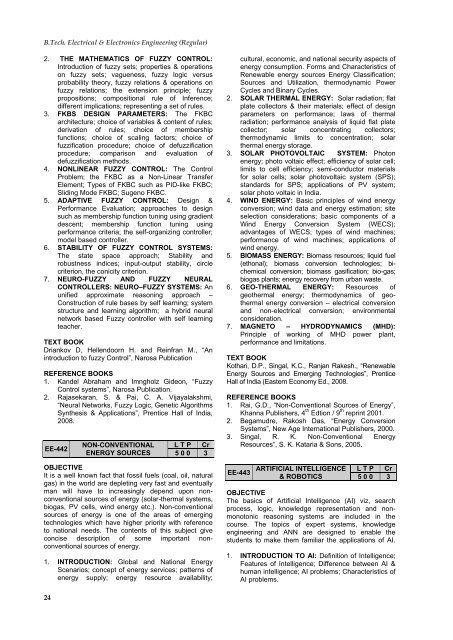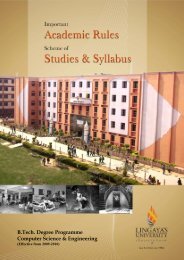Electrical and Electronics - Lingaya's University
Electrical and Electronics - Lingaya's University
Electrical and Electronics - Lingaya's University
Create successful ePaper yourself
Turn your PDF publications into a flip-book with our unique Google optimized e-Paper software.
B.Tech. <strong>Electrical</strong> & <strong>Electronics</strong> Engineering (Regular)2. THE MATHEMATICS OF FUZZY CONTROL:Introduction of fuzzy sets; properties & operationson fuzzy sets; vagueness, fuzzy logic versusprobability theory, fuzzy relations & operations onfuzzy relations; the extension principle; fuzzypropositions; compositional rule of Inference;different implications; representing a set of rules.3. FKBS DESIGN PARAMETERS: The FKBCarchitecture; choice of variables & content of rules;derivation of rules; choice of membershipfunctions; choice of scaling factors; choice offuzzification procedure; choice of defuzzificationprocedure; comparison <strong>and</strong> evaluation ofdefuzzification methods.4. NONLINEAR FUZZY CONTROL: The ControlProblem; the FKBC as a Non-Linear TransferElement; Types of FKBC such as PID-like FKBC;Sliding Mode FKBC; Sugeno FKBC.5. ADAPTIVE FUZZY CONTROL: Design &Performance Evaluation; approaches to designsuch as membership function tuning using gradientdescent; membership function tuning usingperformance criteria; the self-organizing controller;model based controller.6. STABILITY OF FUZZY CONTROL SYSTEMS:The state space approach; Stability <strong>and</strong>robustness indices; input-output stability, circlecriterion, the conicity criterion.7. NEURO-FUZZY AND FUZZY NEURALCONTROLLERS: NEURO–FUZZY SYSTEMS: Anunified approximate reasoning approach –Construction of rule bases by self learning; systemstructure <strong>and</strong> learning algorithm; a hybrid neuralnetwork based Fuzzy controller with self learningteacher.TEXT BOOKDriankov D, Hellendoorn H. <strong>and</strong> Reinfran M., ―Anintroduction to fuzzy Control‖, Narosa PublicationREFERENCE BOOKS1. K<strong>and</strong>el Abraham <strong>and</strong> Imngholz Gideon, ―FuzzyControl systems‖, Narosa Publication.2. Rajasekaran, S. & Pai, C. A. Vijayalakshmi,―Neural Networks, Fuzzy Logic, Genetic AlgorithmsSynthesis & Applications‖, Prentice Hall of India,2008.EE-442NON-CONVENTIONALENERGY SOURCESL T P Cr5 0 0 3OBJECTIVEIt is a well known fact that fossil fuels (coal, oil, naturalgas) in the world are depleting very fast <strong>and</strong> eventuallyman will have to increasingly depend upon nonconventionalsources of energy (solar-thermal systems,biogas, PV cells, wind energy etc.). Non-conventionalsources of energy is one of the areas of emergingtechnologies which have higher priority with referenceto national needs. The contents of this subject giveconcise description of some important nonconventionalsources of energy.1. INTRODUCTION: Global <strong>and</strong> National EnergyScenarios; concept of energy services; patterns ofenergy supply; energy resource availability;cultural, economic, <strong>and</strong> national security aspects ofenergy consumption. Forms <strong>and</strong> Characteristics ofRenewable energy sources Energy Classification;Sources <strong>and</strong> Utilization, thermodynamic PowerCycles <strong>and</strong> Binary Cycles.2. SOLAR THERMAL ENERGY: Solar radiation; flatplate collectors & their materials; effect of designparameters on performance; laws of thermalradiation; performance analysis of liquid flat platecollector; solar concentrating collectors;thermodynamic limits to concentration; solarthermal energy storage.3. SOLAR PHOTOVOLTAIC SYSTEM: Photonenergy; photo voltaic effect; efficiency of solar cell;limits to cell efficiency; semi-conductor materialsfor solar cells; solar photovoltaic system (SPS);st<strong>and</strong>ards for SPS; applications of PV system;solar photo voltaic in India.4. WIND ENERGY: Basic principles of wind energyconversion; wind data <strong>and</strong> energy estimation; siteselection considerations; basic components of aWind Energy Conversion System (WECS);advantages of WECS; types of wind machines;performance of wind machines; applications ofwind energy.5. BIOMASS ENERGY: Biomass resources; liquid fuel(ethonal); biomass conversion technologies; bichemicalconversion; biomass gasification; bio-gas;biogas plants; energy recovery from urban waste.6. GEO-THERMAL ENERGY: Resources ofgeothermal energy; thermodynamics of geothermalenergy conversion – electrical conversion<strong>and</strong> non-electrical conversion; environmentalconsideration.7. MAGNETO – HYDRODYNAMICS (MHD):Principle of working of MHD power plant,performance <strong>and</strong> limitations.TEXT BOOKKothari, D.P., Singal, K.C., Ranjan Rakesh., ―RenewableEnergy Sources <strong>and</strong> Emerging Technologies‖, PrenticeHall of India (Eastern Economy Ed., 2008.REFERENCE BOOKS1. Rai, G.D., ―Non-Conventional Sources of Energy‖,Khanna Publishers, 4 th Edtion / 9 th reprint 2001.2. Begamudre, Rakosh Das, ―Energy ConversionSystems‖, New Age International Publishers, 2000.3. Singal, R. K. Non-Conventional EnergyResources‖, S. K. Kataria & Sons, 2005.EE-443ARTIFICIAL INTELLIGENCE& ROBOTICSL T P Cr5 0 0 3OBJECTIVEThe basics of Artificial Intelligence (AI) viz, searchprocess, logic, knowledge representation <strong>and</strong> nonmonotonicreasoning systems are included in thecourse. The topics of expert systems, knowledgeengineering <strong>and</strong> ANN are designed to enable thestudents to make them familiar the applications of AI.1. INTRODUCTION TO AI: Definition of Intelligence;Features of Intelligence; Difference between AI &human intelligence; AI problems; Characteristics ofAI problems.24
















